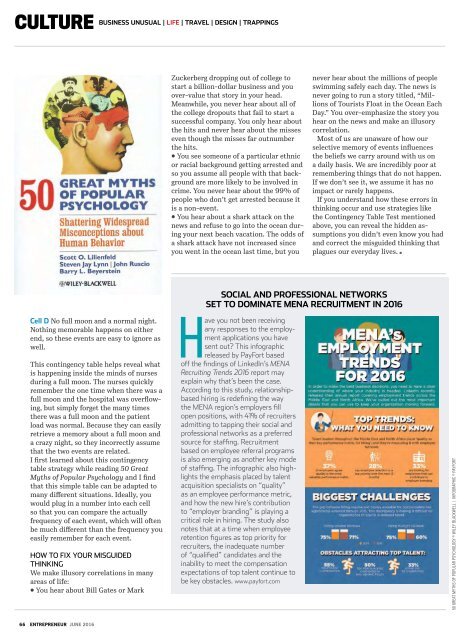THE YEMENI ENTREPRENEURIAL ECOSYSTEM
AgQ69w
AgQ69w
Create successful ePaper yourself
Turn your PDF publications into a flip-book with our unique Google optimized e-Paper software.
CULTURE<br />
business unusual | LIFE | TRAVEL | DESIGN | TRAPPINGS<br />
Zuckerberg dropping out of college to<br />
start a billion-dollar business and you<br />
over-value that story in your head.<br />
Meanwhile, you never hear about all of<br />
the college dropouts that fail to start a<br />
successful company. You only hear about<br />
the hits and never hear about the misses<br />
even though the misses far outnumber<br />
the hits.<br />
• You see someone of a particular ethnic<br />
or racial background getting arrested and<br />
so you assume all people with that background<br />
are more likely to be involved in<br />
crime. You never hear about the 99% of<br />
people who don’t get arrested because it<br />
is a non-event.<br />
• You hear about a shark attack on the<br />
news and refuse to go into the ocean during<br />
your next beach vacation. The odds of<br />
a shark attack have not increased since<br />
you went in the ocean last time, but you<br />
never hear about the millions of people<br />
swimming safely each day. The news is<br />
never going to run a story titled, “Millions<br />
of Tourists Float in the Ocean Each<br />
Day.” You over-emphasize the story you<br />
hear on the news and make an illusory<br />
correlation.<br />
Most of us are unaware of how our<br />
selective memory of events influences<br />
the beliefs we carry around with us on<br />
a daily basis. We are incredibly poor at<br />
remembering things that do not happen.<br />
If we don’t see it, we assume it has no<br />
impact or rarely happens.<br />
If you understand how these errors in<br />
thinking occur and use strategies like<br />
the Contingency Table Test mentioned<br />
above, you can reveal the hidden assumptions<br />
you didn’t even know you had<br />
and correct the misguided thinking that<br />
plagues our everyday lives.<br />
Cell D No full moon and a normal night.<br />
Nothing memorable happens on either<br />
end, so these events are easy to ignore as<br />
well.<br />
This contingency table helps reveal what<br />
is happening inside the minds of nurses<br />
during a full moon. The nurses quickly<br />
remember the one time when there was a<br />
full moon and the hospital was overflowing,<br />
but simply forget the many times<br />
there was a full moon and the patient<br />
load was normal. Because they can easily<br />
retrieve a memory about a full moon and<br />
a crazy night, so they incorrectly assume<br />
that the two events are related.<br />
I first learned about this contingency<br />
table strategy while reading 50 Great<br />
Myths of Popular Psychology and I find<br />
that this simple table can be adapted to<br />
many different situations. Ideally, you<br />
would plug in a number into each cell<br />
so that you can compare the actually<br />
frequency of each event, which will often<br />
be much different than the frequency you<br />
easily remember for each event.<br />
HOW TO FIX YOUR MISGUIDED<br />
THINKING<br />
We make illusory correlations in many<br />
areas of life:<br />
• You hear about Bill Gates or Mark<br />
Social and professional networks<br />
set to dominate MENA recruitment in 2016<br />
Have you not been receiving<br />
any responses to the employment<br />
applications you have<br />
sent out? This infographic<br />
released by PayFort based<br />
off the findings of LinkedIn’s MENA<br />
Recruiting Trends 2016 report may<br />
explain why that’s been the case.<br />
According to this study, relationshipbased<br />
hiring is redefining the way<br />
the MENA region’s employers fill<br />
open positions, with 41% of recruiters<br />
admitting to tapping their social and<br />
professional networks as a preferred<br />
source for staffing. Recruitment<br />
based on employee referral programs<br />
is also emerging as another key mode<br />
of staffing. The infographic also highlights<br />
the emphasis placed by talent<br />
acquisition specialists on “quality”<br />
as an employee performance metric,<br />
and how the new hire’s contribution<br />
to “employer branding” is playing a<br />
critical role in hiring. The study also<br />
notes that at a time when employee<br />
retention figures as top priority for<br />
recruiters, the inadequate number<br />
of “qualified” candidates and the<br />
inability to meet the compensation<br />
expectations of top talent continue to<br />
be key obstacles. www.payfort.com<br />
50 great myths of popular psychology © wiley blackwell | infographic © payfort<br />
66 Entrepreneur june 2016


